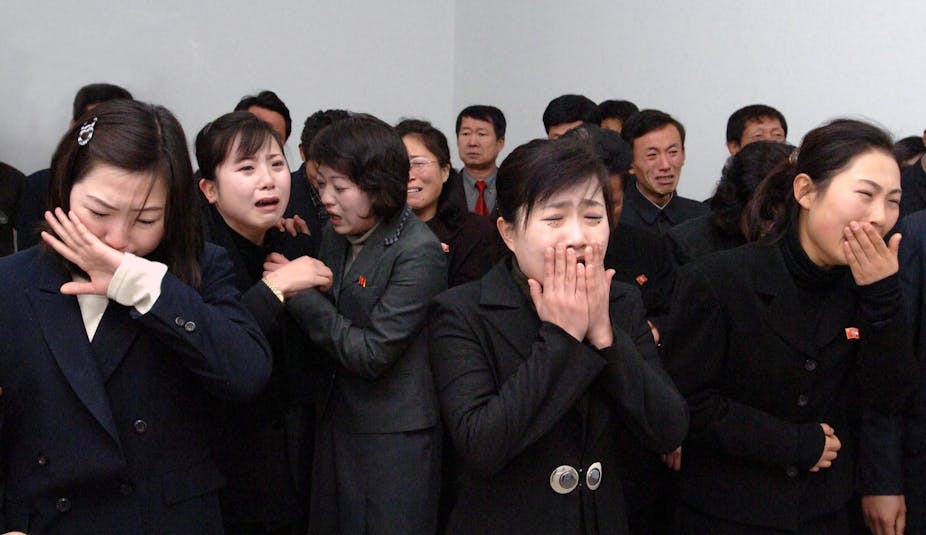Dictators under siege in recent times have issued a range of public statements that seem to share a common theme: expressions of grief. But is that merely a construct of the media?
Juxtapose the prostrate throngs in North Korea who appear to be mourning the passing of their dictator, Kim Jong-il, with the televised statement on the 10th of January by Syria’s Bashar al-Assad.
While the North Koreans appear to be representing grief for a dictator, Assad’s defiant statements mixed with promises of reform can be seen to represent the grief of a dictator. Evident in Assad’s speech are the anger, denial, and bargaining characteristic of the grieving process. It is as though he is providing us with a narrative of his experience of loss.

The most popular model of grieving, that of Elizabeth Kübler-Ross, suggests five dominant emotions: denial; anger; bargaining; depression and; acceptance. Grief theorists contest whether these emotions each occur in a separate stage. They also disagree on how many stages are involved, what emotions dominate in each one, and how long any such stage lasts. But there is general agreement about consistency in the emotions that individuals experience when they face loss.
“Trajectories” of grief and trauma have been suggested by Yale University psychologist, George Bonnano, who studied a range of populations. He identified people who retain an even keel as following a “resilient” trajectory. Those who had several months of depression he characterised as following a “recovery” trajectory. He also identified trajectories of “chronic dysfunction,” which can last for years, and “delayed grief or trauma,” which only surfaces months after an event.
Grief by any other name…
Whether it occurs in stages or trajectories, grief is often recognisable to friends and family. But we are neither Assad’s friends, nor part of his immediate family. And his televised statement may or may not be a genuine representation of his state of mind. So it would be difficult to determine which of Bonnano’s trajectories he may be following since we are not necessarily seeing Assad’s candid response to daily events in Syria.
A colleague and I found, in studying representations of fear by corporate executives, that authenticity in expressing emotions publicly is difficult for even the most open, humane, and progressive leader. And literature on the psychology of shame suggests that exposing one’s emotions to an audience of strangers can reveal vulnerability. So showing emotion is not necessarily what Machiavelli may have recommended to his prince.
One might surmise that Assad’s televised speech could be as tightly scripted as the outpourings of grief captured on video in North Korea. Or, perhaps, Assad’s guard is down, and he’s having a stream of consciousness rant, something not uncharacteristic of tenured rulers, from Cuba’s Castro to Libya’s Gaddafi.

The story at the heart of it
Regardless of whether the apparent emotions are authentic, one can argue that a narrative line can readily be recognised. We see the defiant denial also heard in the statements of the embattled Muammar Gaddafi. And there is the bargaining that was evident in the promise of elections by Yemen’s Ali Abdullah Saleh and Tunisia’s Ben Ali. One wonders if we should expect the depression and accompanying illness experienced on departure by Ben Ali and Egypt’s Hosni Mubarak. The former reportedly had a stroke, and the latter has attended his trial in Egypt on a stretcher.
But do we ever see the “acceptance” portion of the narrative? The Burmese generals may be providing this element. They have released Aung San Suu Kyi from house arrest, promised liberalisation following a recent visit by US Secretary of State Hillary Clinton, and plan a general election for 2015. The Burmese people are reported to be sceptical about these developments. Such scepticism undergirds the distinction between narrative and reality.
That is ultimately my point here. The Arab spring and its counterparts around the world now and in the past are political dramas, with actors and audiences. Though lives are at stake, and many are lost, news accounts retain their distinct narrative streams. The streams are a co-construction by the main actors and the media, and they follow recognisable trajectories. In these cases, the narratives designate a sense of loss by the vanquished figurehead. Such is the time-honoured tale of the grief of dictators.

